Changes in Onset of Vegetation Growth on Svalbard, 2000–2020
Abstract
1. Introduction
2. Materials and Methods
2.1. Study Area
2.2. Processing MODIS Data—Cloud Removal and Interpolation
2.3. Phenological In-Situ Data and Time Series of Sentinel-2 Data
2.4. Mapping the Onset of Vegetation Growth
3. Results
3.1. Comparing Sentinel-2- and MODIS-Based Mapping of Onset of Growth
3.2. Variability and Trends
4. Discussion
4.1. Changes in Onset of Vegetation Growth
4.2. Closing the Spatial and Temporal Gaps
5. Conclusions
Supplementary Materials
Author Contributions
Funding
Data Availability Statement
Acknowledgments
Conflicts of Interest
References
- Buermann, W.; Forkel, M.; O’Sullivan, M.; Sitch, S.; Friedlingstein, P.; Haverd, V.; Jain, A.K.; Kato, E.; Kautz, M.; Lienert, S.; et al. Widespread Seasonal Compensation Effects of Spring Warming on Northern Plant Productivity. Nature 2018, 562, 110–114. [Google Scholar] [CrossRef] [PubMed]
- Isaksen, K.; Nordli; Førland, E.J.; Łupikasza, E.; Eastwood, S.; Niedźwiedź, T. Recent Warming on Spitsbergen-Influence of Atmospheric Circulation and Sea Ice Cover. J. Geophys. Res. 2016, 121, 11931. [Google Scholar] [CrossRef]
- Hanssen-Bauer, I.; Førland, E.; Hisdal, H.; Mayer, S.; Sandø, A. Climate in Svalbard 2100—A Knowledge Base for Climate Adaptation; 2019. Available online: https://repository.oceanbestpractices.org/handle/11329/1382 (accessed on 29 October 2022).
- Isaksen, K.; Nordli, Ø.; Ivanov, B.; Køltzow, M.A.Ø.; Aaboe, S.; Gjelten, H.M.; Mezghani, A.; Eastwood, S.; Førland, E.; Benestad, R.E.; et al. Exceptional Warming over the Barents Area. Sci. Rep. 2022, 12, 9371. [Google Scholar] [CrossRef] [PubMed]
- Xu, L.; Myneni, R.B.; Chapin III, F.S.; Callaghan, T.V.; Pinzon, J.E.; Tucker, C.J.; Zhu, Z.; Bi, J.; Ciais, P.; Tømmervik, H.; et al. Temperature and Vegetation Seasonality Diminishment over Northern Lands. Nat. Clim. Chang. 2013, 3, 581–586. [Google Scholar] [CrossRef]
- Jeganathan, C.; Dash, J.; Atkinson, P.M. Remotely Sensed Trends in the Phenology of Northern High Latitude Terrestrial Vegetation, Controlling for Land Cover Change and Vegetation Type. Remote Sens. Environ. 2014, 143, 154–170. [Google Scholar] [CrossRef]
- Park, T.; Ganguly, S.; Tømmervik, H.; Euskirchen, E.S.; Høgda, K.A.; Karlsen, S.R.; Brovkin, V.; Nemani, R.R.; Myneni, R.B. Changes in Growing Season Duration and Productivity of Northern Vegetation Inferred from Long-Term Remote Sensing Data. Environ. Res. Lett. 2016, 11, 084001. [Google Scholar] [CrossRef]
- Høgda, K.A.; Tømmervik, H.; Karlsen, S.R. Trends in the Start of the Growing Season in Fennoscandia 1982–2011. Remote Sens. 2013, 5, 4304–4318. [Google Scholar] [CrossRef]
- Berner, L.T.; Massey, R.; Jantz, P.; Forbes, B.C.; Macias-Fauria, M.; Myers-Smith, I.; Kumpula, T.; Gauthier, G.; Andreu-Hayles, L.; Gaglioti, B.V.; et al. Summer Warming Explains Widespread but Not Uniform Greening in the Arctic Tundra Biome. Nat. Commun. 2020, 11, 4621. [Google Scholar] [CrossRef]
- Fensholt, R.; Proud, S.R. Evaluation of Earth Observation Based Global Long Term Vegetation Trends—Comparing GIMMS and MODIS Global NDVI Time Series. Remote Sens. Environ. 2012, 119, 131–147. [Google Scholar] [CrossRef]
- Tian, F.; Fensholt, R.; Verbesselt, J.; Grogan, K.; Horion, S.; Wang, Y. Evaluating Temporal Consistency of Long-Term Global NDVI Datasets for Trend Analysis. Remote Sens. Environ. 2015, 163, 326–340. [Google Scholar] [CrossRef]
- Guay, K.C.; Beck, P.S.A.; Berner, L.T.; Goetz, S.J.; Baccini, A.; Buermann, W. Vegetation Productivity Patterns at High Northern Latitudes: A Multi-Sensor Satellite Data Assessment. Glob. Change Biol. 2014, 20, 3147–3158. [Google Scholar] [CrossRef]
- Myers-Smith, I.H.; Kerby, J.T.; Phoenix, G.K.; Bjerke, J.W.; Epstein, H.E.; Assmann, J.J.; John, C.; Andreu-Hayles, L.; Angers-Blondin, S.; Beck, P.S.A.; et al. Complexity Revealed in the Greening of the Arctic. Nat. Clim. Chang. 2020, 10, 106–117. [Google Scholar] [CrossRef]
- Karlsen, S.R.; Elvebakk, A.; Høgda, K.A.; Grydeland, T. Spatial and Temporal Variability in the Onset of the Growing Season on Svalbard, Arctic Norway—Measured by MODIS-NDVI Satellite Data. Remote Sens. 2014, 6, 8088–8106. [Google Scholar] [CrossRef]
- Norwegian Centre for Climate Services. Meterological Data. Available online: https://seklima.met.no/observations/ (accessed on 23 October 2022).
- Karlsen, S.R.; Stendardi, L.; Tømmervik, H.; Nilsen, L.; Arntzen, I.; Cooper, E.J. Time-Series of Cloud-Free Sentinel-2 NDVI Data Used in Mapping the Onset of Growth of Central Spitsbergen, Svalbard. Remote Sens. 2021, 13, 3031. [Google Scholar] [CrossRef]
- Johansen, B.E.; Karlsen, S.R.; Tømmervik, H. Vegetation Mapping of Svalbard Utilising Landsat TM/ETM+ Data. Polar Rec. 2012, 48, 47–63. [Google Scholar] [CrossRef]
- Camps-Valls, G.; Munoz-Mari, J.; Gomez-Chova, L.; Guanter, L.; Calbet, X. Nonlinear Statistical Retrieval of Atmospheric Profiles From MetOp-IASI and MTG-IRS Infrared Sounding Data. IEEE Trans. Geosci. Remote Sens. 2012, 50, 1759–1769. [Google Scholar] [CrossRef]
- Belda, S.; Pipia, L.; Morcillo-Pallarés, P.; Rivera-Caicedo, J.P.; Amin, E.; de Grave, C.; Verrelst, J. DATimeS: A Machine Learning Time Series GUI Toolbox for Gap-Filling and Vegetation Phenology Trends Detection. Environ. Model. Softw. 2020, 127, 104666. [Google Scholar] [CrossRef]
- Karlsen, S.R.; Høgda, K.-A. Endringer i Start På Vekstsesongen På Svalbard i Relasjon Til Klima; NORUT: Tromsø, Norway, 2014. [Google Scholar]
- Hansen, B.B.; Isaksen, K.; Benestad, R.E.; Kohler, J.; Pedersen, Å.Ø.; Loe, L.E.; Coulson, S.J.; Larsen, J.O.; Varpe, Ø. Warmer and Wetter Winters: Characteristics and Implications of an Extreme Weather Event in the High Arctic. Environ. Res. Lett. 2014, 9, 114021. [Google Scholar] [CrossRef]
- Bjerke, J.W.; Treharne, R.; Vikhamar-Schuler, D.; Karlsen, S.R.; Ravolainen, V.; Bokhorst, S.; Phoenix, G.K.; Bochenek, Z.; Tømmervik, H. Understanding the Drivers of Extensive Plant Damage in Boreal and Arctic Ecosystems: Insights from Field Surveys in the Aftermath of Damage. Sci. Total Environ. 2017, 599–600 (Suppl. 3), 1965–1976. [Google Scholar] [CrossRef]
- Anderson, H.B.; Nilsen, L.; Tømmervik, H.; Karlsen, S.R.; Nagai, S.; Cooper, E.J. Using Ordinary Digital Cameras in Place of Near-Infrared Sensors to Derive Vegetation Indices for Phenology Studies of High Arctic Vegetation. Remote Sens. 2016, 8, 847. [Google Scholar] [CrossRef]
- Clark, W.C. Scales of Climate Impacts. Clim. Change 1985, 7, 5–27. [Google Scholar] [CrossRef]
- May, J.L.; Parker, T.; Unger, S.; Oberbauer, S.F. Short Term Changes in Moisture Content Drive Strong Changes in Normalized Difference Vegetation Index and Gross Primary Productivity in Four Arctic Moss Communities. Remote Sens. Environ. 2018, 212, 114–120. [Google Scholar] [CrossRef]


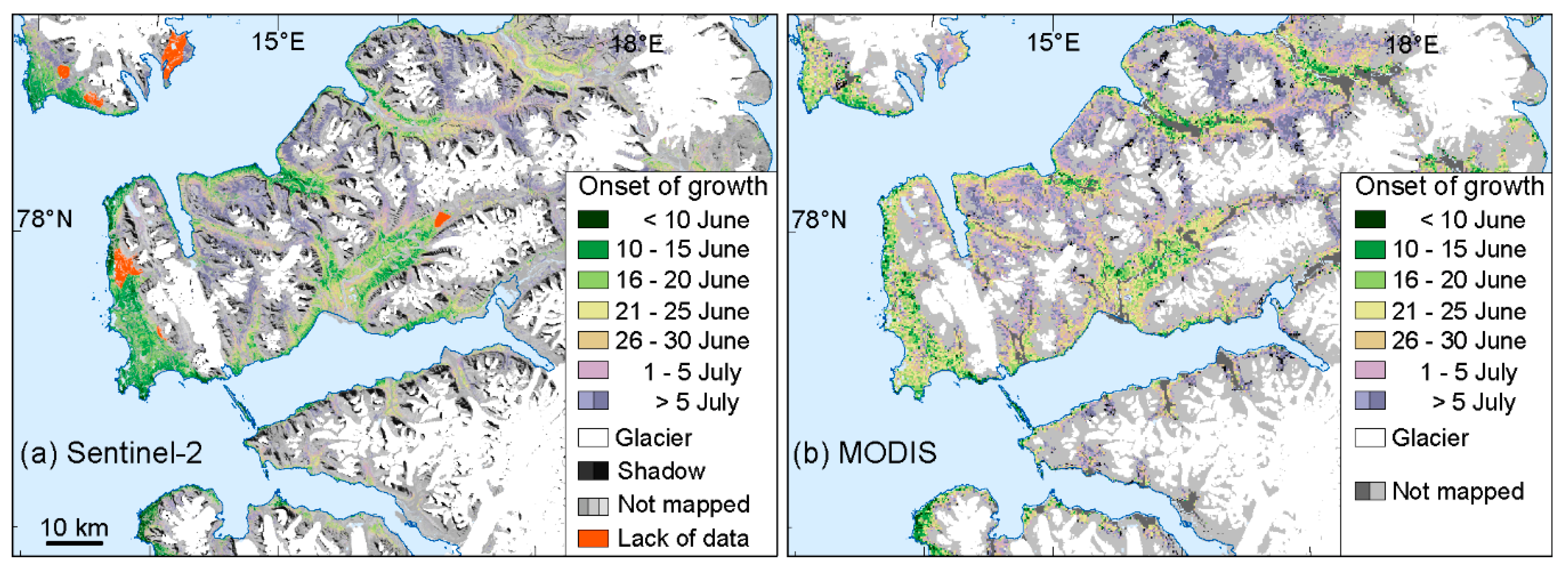
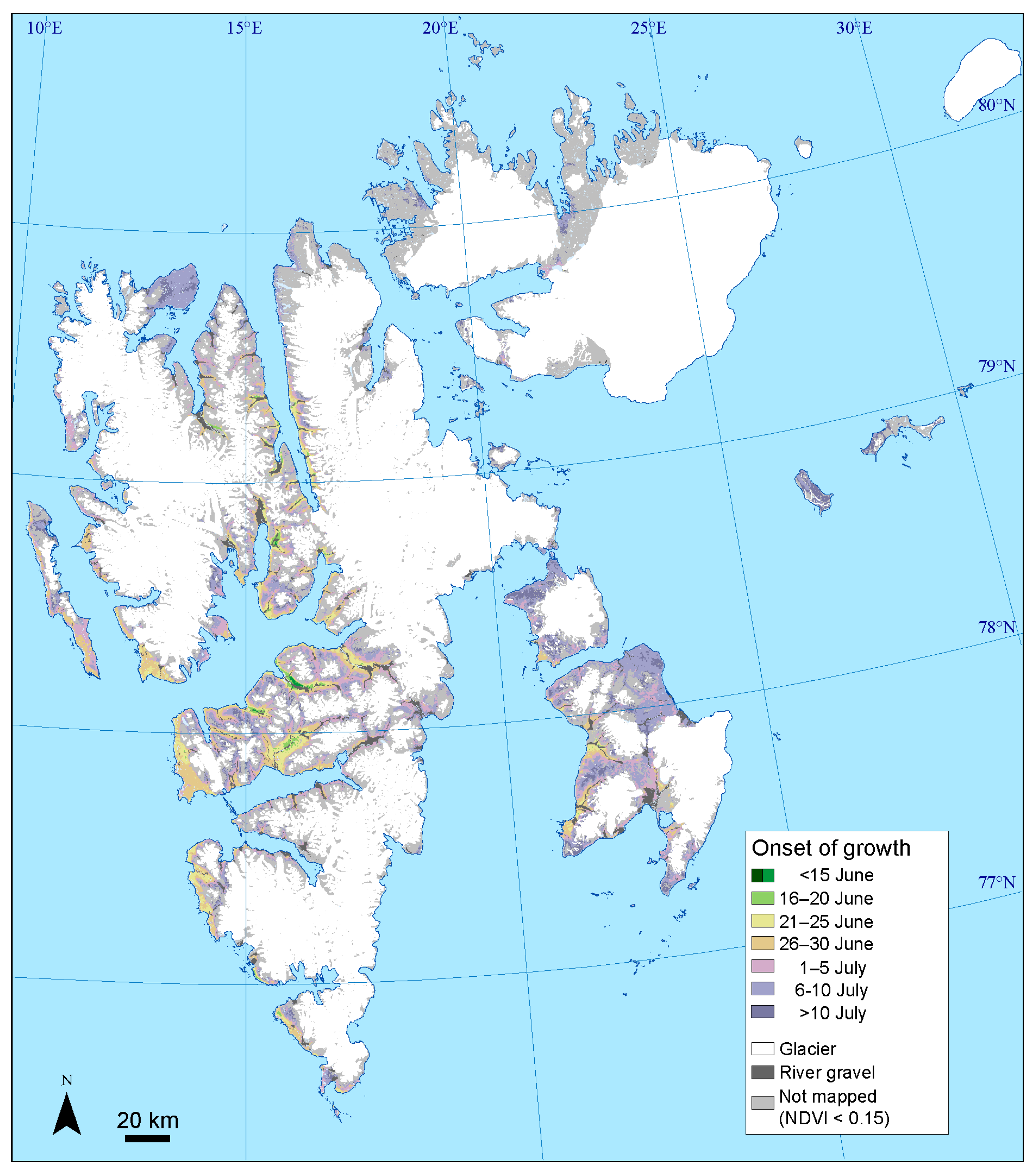
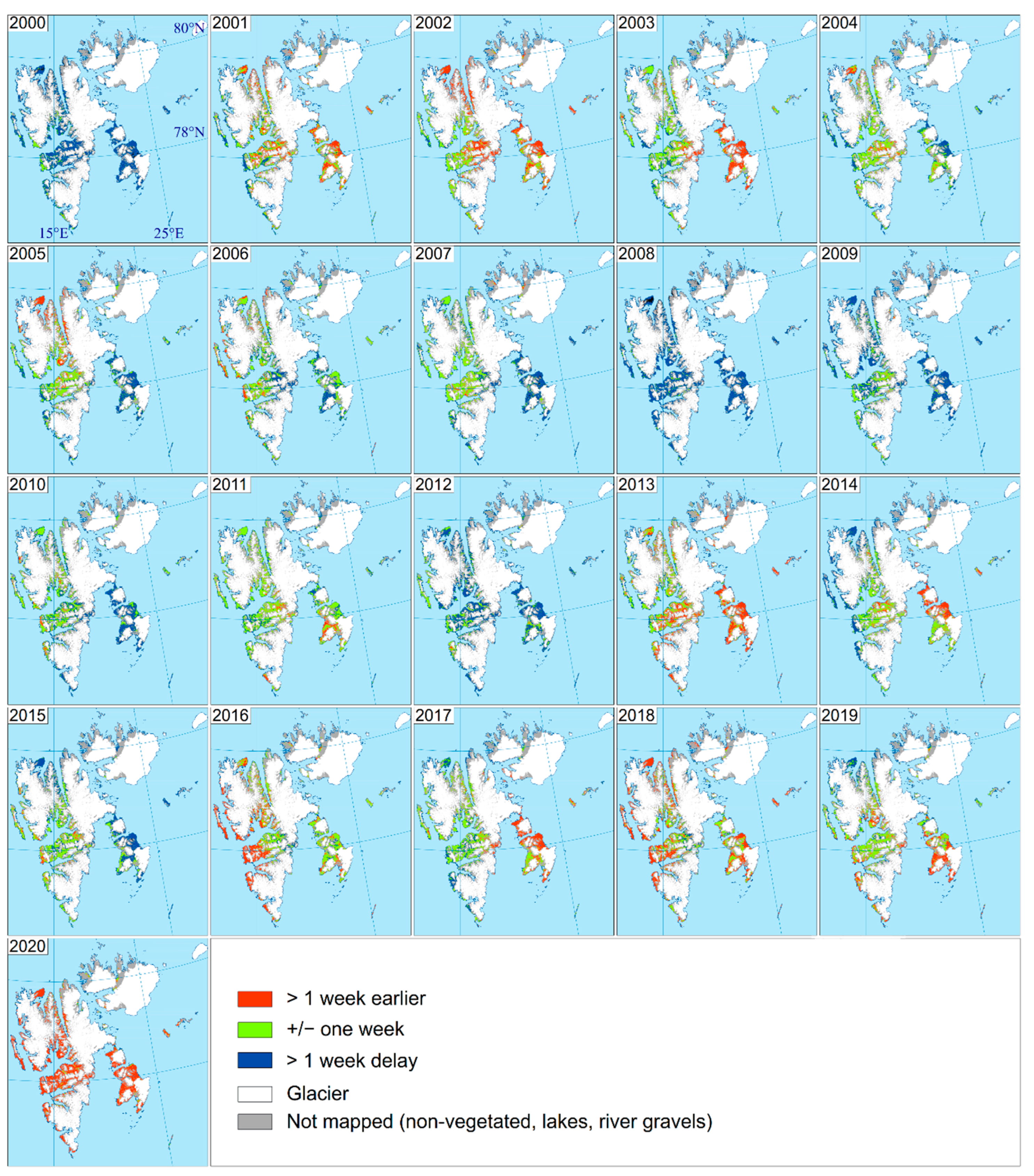
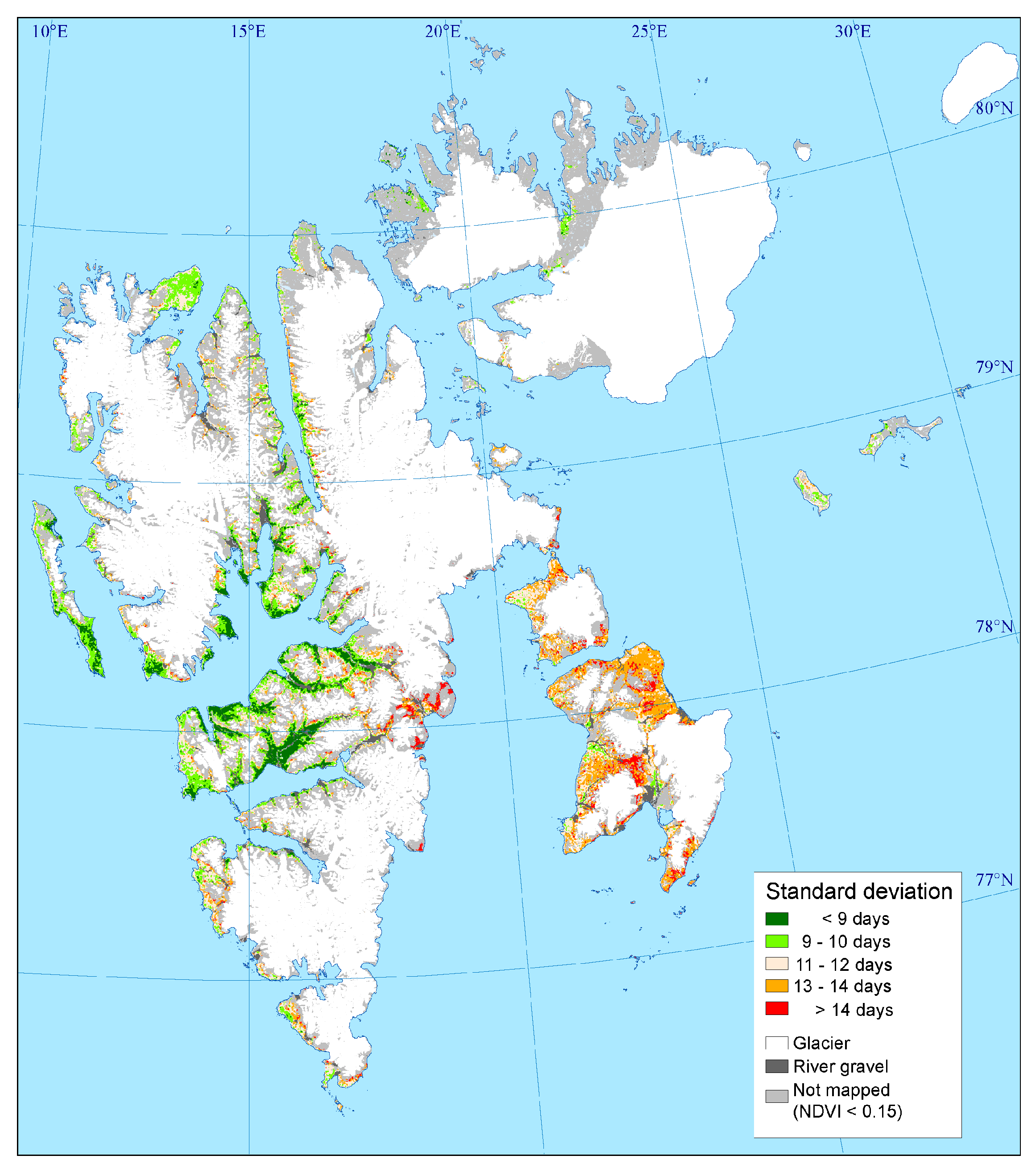
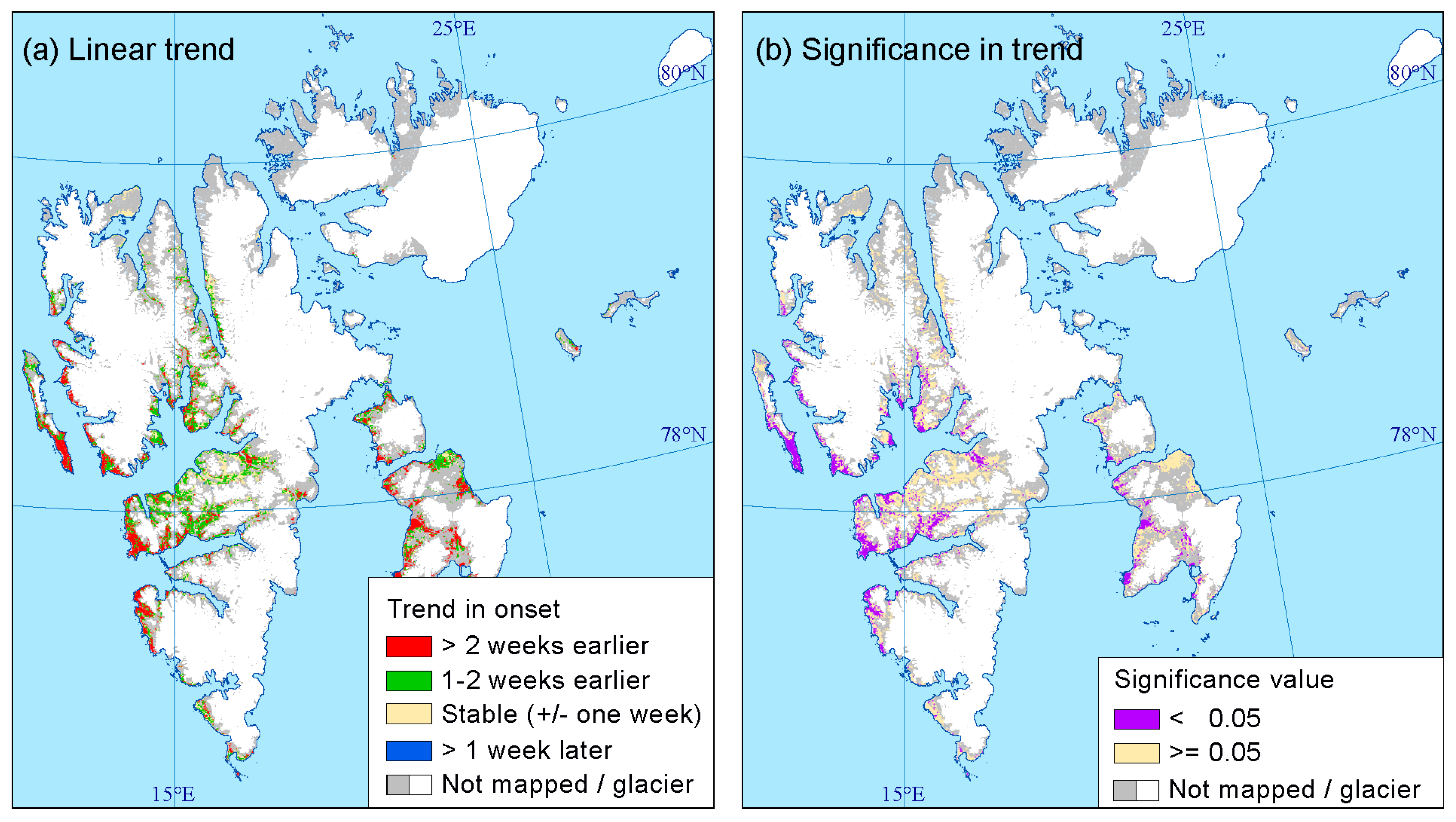
| Station Number and Name | May | June | July | August | Annual |
|---|---|---|---|---|---|
| 99840 Svalbard Lufthavn | |||||
| Mean | –1.53 | 3.99 | 7.36 | 6.33 | –3.15 |
| Linear trend | 2.27 | 1.65 ** | 1.83 ** | 0.44 | 2.55 ** |
| 99910 Ny-Ålesund | |||||
| Mean | –1.95 | 2.96 | 6.08 | 4.76 | −3.61 |
| Linear trend | 2.49 * | 1.52 * | 1.61 ** | 0.76 | 2.18 ** |
Publisher’s Note: MDPI stays neutral with regard to jurisdictional claims in published maps and institutional affiliations. |
© 2022 by the authors. Licensee MDPI, Basel, Switzerland. This article is an open access article distributed under the terms and conditions of the Creative Commons Attribution (CC BY) license (https://creativecommons.org/licenses/by/4.0/).
Share and Cite
Karlsen, S.R.; Elvebakk, A.; Tømmervik, H.; Belda, S.; Stendardi, L. Changes in Onset of Vegetation Growth on Svalbard, 2000–2020. Remote Sens. 2022, 14, 6346. https://doi.org/10.3390/rs14246346
Karlsen SR, Elvebakk A, Tømmervik H, Belda S, Stendardi L. Changes in Onset of Vegetation Growth on Svalbard, 2000–2020. Remote Sensing. 2022; 14(24):6346. https://doi.org/10.3390/rs14246346
Chicago/Turabian StyleKarlsen, Stein Rune, Arve Elvebakk, Hans Tømmervik, Santiago Belda, and Laura Stendardi. 2022. "Changes in Onset of Vegetation Growth on Svalbard, 2000–2020" Remote Sensing 14, no. 24: 6346. https://doi.org/10.3390/rs14246346
APA StyleKarlsen, S. R., Elvebakk, A., Tømmervik, H., Belda, S., & Stendardi, L. (2022). Changes in Onset of Vegetation Growth on Svalbard, 2000–2020. Remote Sensing, 14(24), 6346. https://doi.org/10.3390/rs14246346










